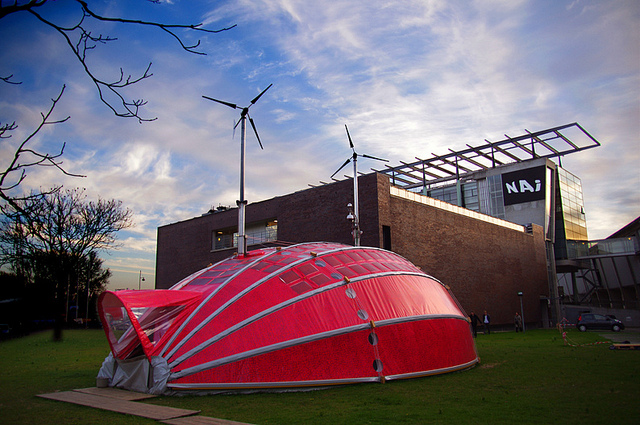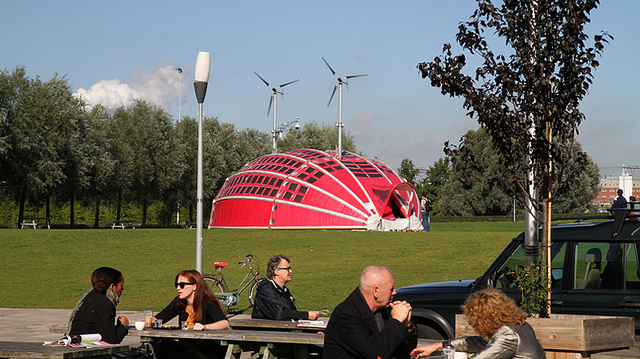#GC2022 is accepting submissions - 25d 27h 05m 44s
Modern Nomadism
Inspired by Jared Diamond's remark that the largest mistake humanity ever made was settling down in agricultural and later industrial societies, and the personal experience that continuous movement seems to be the lifestyle fitting best with human needs and aspirations nomadism is a central theme in the development of the World in a Shell project. Superficially, it seems to contradict the common opinion and long-term policy of many governments to forcibly settle down the nomads and provide them and their other citizens with a few square meters of living space in suburbia, ghetto's or shantytowns.
Some people are celebrating the 21-century as the century of the city - more than half of the human population is now living in cities, suggesting that their inhabitants have a better and fuller life as before. But they overlook the unstable side of the cities, their lack of community, their gangs and crimes. The influx of people is not an act of free choice, but a consequence of poverty, exploitation and in many cases a forced movement instigated by government policies, and land grabbing by multinationals and the rich. Nomadism, modern nomadism is on the rise and climate change and the unequal distribution of wealth on a local and global scale will only push more people to move from their ancestral lands just simply to survive. It looks like that the ecological refugee will be more characteristic of the 21 century than the happy human beehive of the city propagators.

World in a Shell virtual image in the Kalahari Desert | Photography and photoshopping by Hans Kalliwoda
Also in the western world, more and more people are on the move. Some of them, the e-culture nomads, use computer technology and the internet to be able to work at any place they fancy. Others, the vast majority of the migrants have less choice. Companies want their employees to be flexible and move to wherever the companies' profits dictate them to go. Then there is this vast and growing river of cheap labourers that despite fences, barbed wire, persecution, discrimination and other forms of inhuman treatment flock to the 'gold covered' streets of the metropoles where as modern, voluntary slaves, they have to live on the crumbs of the mighty. One can hardly call them nomads in a traditional sense as they have hardly any control over their lives nor their environment. But, still, people are on a massive scale on the move, and it is high time not to try to contain these migrations but to use the human resources to develop tools and technology for a modern form of nomadism.
To develop mobile living and working units that are durable and can function independently of their environment, and as a good nomadic technology does not harm the environment and leaves no lasting imprint, while at the same time it stimulates open borders and true intercultural meetings.
The World in a Shell - The polliniferous project

World in a Shell on exhibition at the Museumpark, Rotterdam, hosted by the Netherlands Architecture institute
and V2_, Spring 2010 | Photography by Michi Meier
The polliniferous project and the World in a Shell wants to be just that, an example of what modern nomadism could be, a living cultural heritage for the 21st century with roots going back to the forms of civilization that have proven to be the most long-lasting and most in tune with the environment and the other sentient beings.
The World in a Shell is a mobile artist's studio, which functions as an intercultural swap-shop. Being an intervention project by nature it focuses on developments rather than on results. The locations are in areas inhabited by indigenous peoples in the proximity of UNESCO World Heritage Sites where the World in a Shell will function as an interactive communication zone to facilitate a "self-documentation" of the people, cultures, living conditions and the surroundings of these sites, and thus turn into the first living and mobile world heritage site.
The essence of everything that happens, whether experienced, imagined or created in and around the shell, will be captured and stored in a treasure box in the form of 'unica', (pictures, drawings, recordings, stories, self-representations and art works). The treasure box will be shown to the people on the next location and during exhibitions in musea and on biennales.
In such a way, people from one location will travel along to the next and interact with the people over there. At the same time, people from all over the world can connect to the World in a Shell through the internet and follow, or participate, in the project and become themselves part of the world peoples heritage treasure box.
The project demands interaction, involvement, communication, and a multi-disciplinary form of collaboration. By drawing people into situations where they actively participate in the working processes they become part of the project and the art-work itself. On locations the focus lies primarily on local people, portraying their habits, passions and fears by using the shell as a laboratory for artistic research. Creating interactive communication zones, where a dialogue between the artist, the public and the arts can take place.

World in a Shell on exhibition at the Westerpark, Amsterdam, Autumn 2010 | Photography by Michi Meier
-----------
The World in a Shell aims to trigger rethinking of everyday life and hints for solutions on autonomy and decentralization. It also aims at arising issues such as migration, ecotourism and human sustainability. Technology is not the aim, but the tool with which to facilitate exchange. Being a large 'walk-in-sculpture', the World in a Shell acts as an intercultural swap shop and as a vehicle for intellectual cross-pollination on exhibitions and at UNESCO World Heritage Sites.
The first destination of The World in a Shell out of Holland is the Kalahari Desert in Botswana. The Kalahari Desert is considered to be the cradle of life from where the Homo sapiens or 'Modern Humans' started to spread all over the world. It is here that you find the 'San' or Bushmen rock painting and artefacts possibly up to 70.000 years old with evidence on their distinct hunter-gatherer culture. Through their development of excellent hunting and tracking techniques, their skill in finding water and deep under-standing of their surrounding nature, they have managed to sustain themselves for millennia and have thus proven to be one of the utmost sustainable culture on planet earth.
Artist: Hans Kalliwoda
More info about this installation artwork at www.worldinashell.net